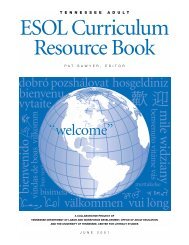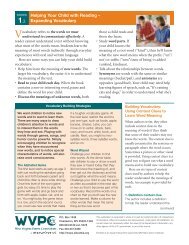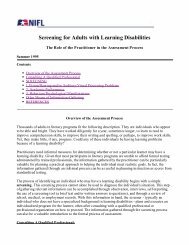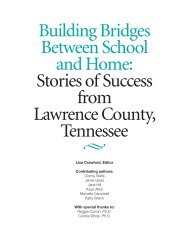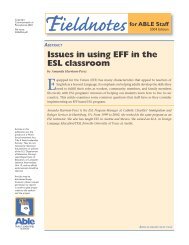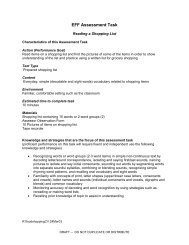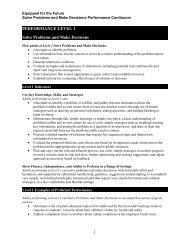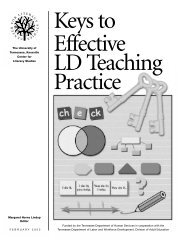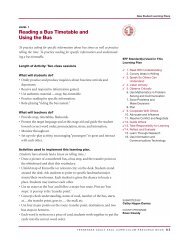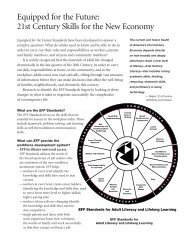Equipped for the Future Assessment Report: How Instructors Can ...
Equipped for the Future Assessment Report: How Instructors Can ...
Equipped for the Future Assessment Report: How Instructors Can ...
Create successful ePaper yourself
Turn your PDF publications into a flip-book with our unique Google optimized e-Paper software.
E Q U I P P E D F O R T H E F U T U R E A S S E S S M E N T R E P O R T<br />
Per<strong>for</strong>mance-based assessment is grounded<br />
in <strong>the</strong>ories of learning that emphasize making meaning<br />
through thinking and doing.<br />
student per<strong>for</strong>mance—that is, enough of <strong>the</strong><br />
right kind of in<strong>for</strong>mation to draw solid conclusions<br />
about student achievement.<br />
■ Accurate assessment, free of bias and distortion.<br />
To ensure accuracy and freedom from bias<br />
and distortion, per<strong>for</strong>mance-based assessments<br />
must be carefully designed and reviewed prior to<br />
use. Because human judgment is often relied on in<br />
evaluating per<strong>for</strong>mance on alternative assessment<br />
tasks, evaluator bias or prejudice must be avoided.<br />
Linked Directly to Standards<br />
The EFF Standards establish challenging expectations<br />
<strong>for</strong> learning. They set goals to guide curriculum<br />
and instruction and also provide a common set of<br />
criteria that can be used to evaluate student learning.<br />
Per<strong>for</strong>mance-based assessment tools should be carefully<br />
designed to measure student progress towards<br />
achieving EFF Standards. Specifically, assessments<br />
must require students to demonstrate <strong>the</strong> particular<br />
knowledge, skills, and modes of thinking described<br />
by <strong>the</strong> Standards so that accurate inferences can be<br />
drawn about student achievement relative to <strong>the</strong>se<br />
Standards. For example, if an assessment is supposed<br />
to measure <strong>the</strong> Standard Speak so that O<strong>the</strong>rs <strong>Can</strong><br />
Understand, a multiple-choice test will not suffice<br />
because it does not directly involve <strong>the</strong> targeted skill,<br />
speaking. The assessment task that targets this Standard<br />
should require <strong>the</strong> student to demonstrate<br />
effective speaking skills (e.g., engage in a dialogue;<br />
give an extemporaneous answer to a question; make<br />
a <strong>for</strong>mal oral presentation) and evaluate his or her<br />
ability to speak in a way that o<strong>the</strong>rs can understand<br />
according to <strong>the</strong> criteria specified in <strong>the</strong> Standard’s<br />
components of per<strong>for</strong>mance.<br />
In addition to linking to Standards, per<strong>for</strong>mance-based<br />
assessments should also link directly<br />
to instruction—that is, to what students are actually<br />
taught and have <strong>the</strong> opportunity to learn. <strong>Assessment</strong>s<br />
should mirror instructional strategies that are<br />
regularly used with students. For example, <strong>the</strong> experience<br />
of many large-scale student assessment programs<br />
is that students who have not had <strong>the</strong><br />
opportunity to write essays and internalize principles<br />
of good writing in class tend to per<strong>for</strong>m poorly<br />
on <strong>the</strong> essay components of statewide assessments.<br />
There<strong>for</strong>e, if students are expected to demonstrate<br />
effective writing skills, <strong>the</strong>n <strong>the</strong>y should have sufficient<br />
opportunities in <strong>the</strong> classroom to develop and<br />
use <strong>the</strong>se skills be<strong>for</strong>e being assessed on <strong>the</strong>m.<br />
Grounded in Theories of Learning<br />
Per<strong>for</strong>mance-based assessment is grounded in <strong>the</strong>ories<br />
of learning that emphasize making meaning<br />
through thinking and doing. For example, constructivism<br />
holds that knowledge is actively constructed<br />
and that individuals create meaning by taking an<br />
active role in <strong>the</strong>ir own learning. That is, <strong>the</strong>y learn<br />
by writing, discussing, creating products, and making<br />
decisions about learning. They do not learn as<br />
well by passive participation, simply listening to <strong>the</strong><br />
instructor and restating what <strong>the</strong> instructor says<br />
(Newmann, et. al., 1995).<br />
The concept of contextual teaching and learning<br />
also underlies <strong>the</strong> application of per<strong>for</strong>mancebased<br />
assessment. Simply stated, students learn and<br />
per<strong>for</strong>m best in context. For example, students better<br />
understand and internalize statistical concepts by<br />
actually conducting and analyzing a survey ra<strong>the</strong>r<br />
than simply responding to statistical problems<br />
presented in a textbook, devoid of any meaningful<br />
context. Per<strong>for</strong>mance-based assessment tasks, like<br />
contextual learning tasks, use real-life applications<br />
to rein<strong>for</strong>ce academic knowledge and skills.<br />
Per<strong>for</strong>mance-based assessment also acknowledges<br />
<strong>the</strong> important role of social interaction in<br />
learning. Many <strong>the</strong>ories of intellectual development<br />
recognize that interaction facilitates intellectual<br />
6



